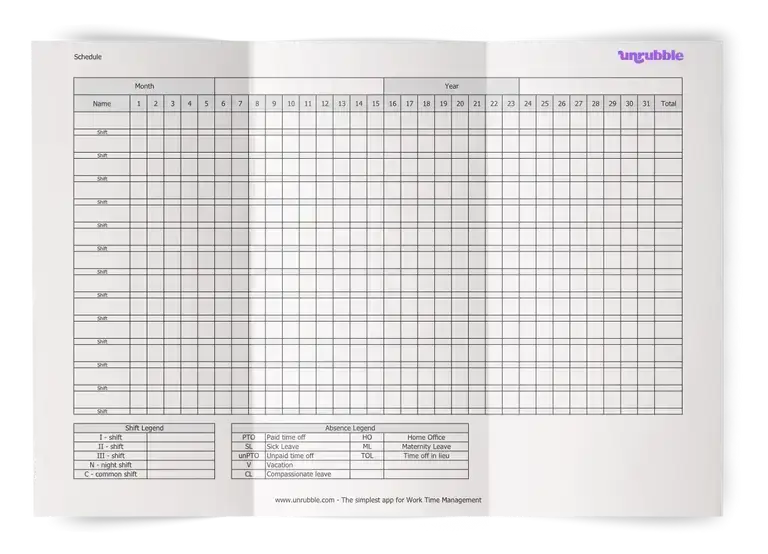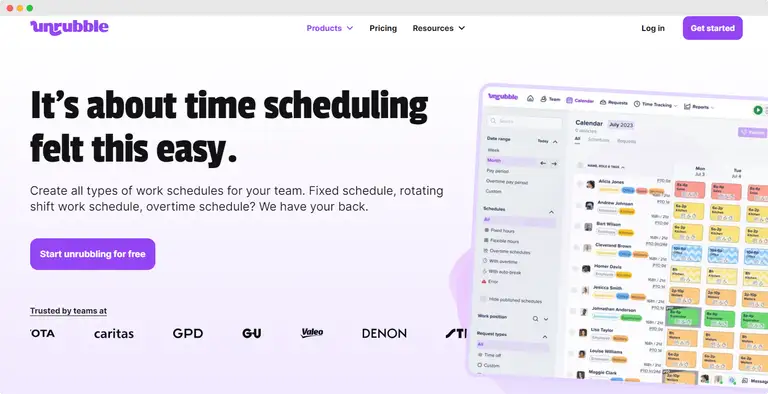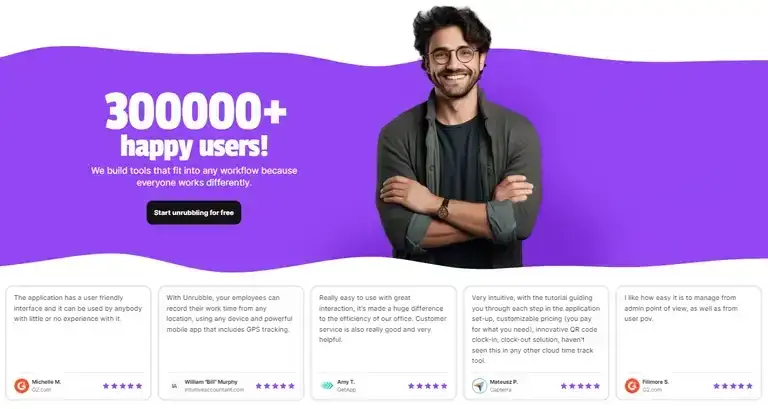Healthcare staff scheduling is a multi-layered challenge.
Too few staff members, and patient care suffers. Too many, and operating costs skyrocket.
Fortunately, we have reached a time when you no longer have to manually plan the work of your medical team. With the right tools and strategies, you can optimize schedules, improve patient satisfaction, and reduce staff burnout.
Let's explore the importance of staff scheduling in healthcare, the challenges involved, as well as the best practices.
The importance of staff scheduling in healthcare

One of the fundamental aims of healthcare staff scheduling is ensuring patients get the care they need and when they need it.
The healthcare industry operates 24/7, with varying shift patterns. As a result, there are major challenges associated with making sure the right staff is available at the right times.
Even small mismanagement errors can lead to strained resources, overtime hours, burnout, or worse - compromised treatment.
Moreover, the complexity of managing schedules increases with factors like workers' availability, the need for specialized skills, and unexpected absences.
Healthcare organizations face a major challenge: they must juggle these factors and still deliver quality patient service.
And all without overburdening their employees.
That's why having a user-friendly, efficient scheduling system is a necessity.
Many healthcare facilities still rely on manual scheduling methods that can be time-consuming and prone to human errors. Meanwhile, digital tools are the future.
Examples include healthcare scheduling software solutions that streamline shift scheduling and optimize staff utilization.
Such scheduling software for healthcare brings many other benefits, for example:
- allows for real-time updates
- makes it easier to manage employee schedules and availability
- reduces the risk of human error
- maintains compliance with labor laws
- improves overall company efficiency
Therefore, those organizations that adopt digital scheduling tools will be better equipped to meet patient needs, improve staff well-being, enable efficient workforce management, and meet regulatory requirements.
Challenges of healthcare staff scheduling

Scheduling healthcare staff isn't as simple as plugging people into a calendar. Here are significant challenges that need to be managed if you want to enjoy effective staff schedules.
Ensuring 24/7 coverage
Healthcare facilities, from hospitals to urgent care centers, require staff to be present all the time, literally 24 hours a day, 7 days a week.
For example, in hospitals, emergency room staff need to be available at all hours, regardless of holidays or weekends.
This means schedules must include coverage for many different shifts.
Managing diverse staff roles and expertise
Another major challenge is the complexity of scheduling different types of healthcare professionals, each with their unique qualifications, responsibilities, and availability.
For example, a hospital's staff might include:
- doctors
- nurses
- lab technicians
- specialists
- and administrative personnel
So, people in charge of planning need to know how to manage different employees and arrange their work properly.
Compliance with labor laws and regulations
Healthcare scheduling requires strict adherence to regulations, labor laws, and union agreements. Laws governing maximum working hours, mandatory rest periods, and the number of consecutive shifts add further complexity to the process.
Healthcare providers must also comply with staffing regulations that protect patient safety, such as nurse-to-patient ratios.
For instance, hospitals can be penalized if they do not follow union agreements or exceed the allowed working hours for healthcare workers. A misstep in this area can result in legal and financial consequences, not to mention staff dissatisfaction.
Avoiding burnout and ensuring staff well-being
Overworked staff are more likely to make mistakes, become dissatisfied with their jobs, burn out, and leave your organization.
The problem is that poor planning practices, such as assigning back-to-back shifts or consistently scheduling employees for nights or weekends, can contribute to these drawbacks.
Managers must create more balanced schedules that distribute workload evenly across the team.
Best practices for effective healthcare staff scheduling

Given the constant need for balance between offered care, employee well-being, and operational efficiency, you may feel overwhelmed. However, adopting best practices can make a huge difference.
Implement a fair and transparent scheduling process
With the right approach, you build trust and reduce conflict among healthcare employees.
To make the scheduling process fair and transparent, you can:
- Involve staff - encourage eligible employees to participate in the process by sharing their availability and preferences.
- Explain the criteria - make the criteria (like seniority, shift needs, etc.) clear to all staff members.
- Use staff scheduling software - a digital system can make schedules more transparent and accessible, helping to avoid misunderstandings.
- Provide flexibility - include options for shift swaps to accommodate personal commitments.
Use predictive scheduling
Predictive scheduling can forecast staffing needs based on trends such as patient load, historical data, and seasonality. Together with data analytics and staff scheduling software, it can prepare healthcare organizations in advance for busy periods and avoid the need for last-minute changes.
This helps companies control labor costs and optimize them because they will be able to:
- avoid overstaffing
- prevent costly overtime hours
- and ensure sufficient coverage during peak times
Cross-train your staff
Next, consider cross-training your healthcare staff. It may not seem obvious, but provides flexibility, as employees can cover multiple roles. For example, an RN to MSN graduate nurse trained in administrative tasks can step in to cover front-desk duties when needed. Or administrative personnel who know how to perform first aid can help in an emergency.
While this won't be a permanent solution, it can address a variety of scheduling needs and help practice managers cover shifts without compromising the quality of offered services.
Regularly review and adjusting schedules
Healthcare is unpredictable, so keep in mind to regularly review and adjust plans as needed.
You can use a staff scheduling software which allows for quick updates to employee hours and shows whether the facility is actually adequately staffed.
Moreover, as things can occasionally go off schedule, it's a good idea to have backup plans. Make sure these plans are effective, up-to-date, and immediately usable.
The role of digital tools in healthcare scheduling

Manual scheduling methods often fall short in healthcare settings, where the stakes are incredibly high. Imagine trying to manage multiple healthcare workers, shifts, and last-minute changes with a spreadsheet.
It’s a recipe for confusion.
Errors in manual planning can result in misunderstanding, missed shifts, and directly impact patient care or morale. The lack of real-time updates adds to the frustration, as healthcare professionals work on outdated work schedules and create more confusion.
Digital scheduling tools come in as the game-changer in this industry.
They can overcome hurdles and create a system that supports both staff and patients.
How?
- With healthcare staff scheduling software and features like automated reminders or mobile access, healthcare employees can be notified about upcoming shifts or changes.
- Medical facilities can use a scheduling app to map out which professionals are needed for each shift, filter staff by skills, certifications, or experience, and even assign specialists based on patient demand.
- Also, employee scheduling software simplifies compliance by integrating local labor laws and union rules directly into the scheduling process.
- Healthcare scheduling software provides real-time updates, reduces human errors, and streamline the entire process.
As you can see, the right digital tools and strategies are invaluable.
Sounds like a win-win, right?
Take St. Luke’s Health System as an example.
Before transitioning to digital scheduling, they struggled with manual methods that led to staffing inefficiencies and errors.
After implementing a healthcare-specific scheduling software, they saw immediate benefits like providing thousands of healthcare providers with the ability to access the same patient's medical records, and enhanced staff satisfaction.
With examples like St. Luke’s, it’s clear that if you want to improve efficiency and employee well-being, digital tools are no longer just a luxury.
Checklist of essential features for healthcare scheduling tools

When choosing a healthcare staff scheduling software, there are the essential features to look for.
Check them out with our simple checklist:
- Automated shift assignments - to automatically assign shifts based on staff availability and qualifications.
- Real-time updates - to guarantee that any changes to the schedule are updated instantly, so employees are always in the loop.
- Compliance tracking - to monitor hours worked and verify compliance with labor laws, including mandatory rest periods and overtime regulations.
- Integration with payroll systems - to streamline the payroll process by connecting scheduling systems directly to payroll providers and ensure that employee hours are accurately compensated.
- Mobile access - to give employees the possibility to schedule, check shifts, or get updates from their mobile devices.
The ideal solution for healthcare staff scheduling? Unrubble!
Meet Unrubble - the ultimate tool to help you streamline your scheduling!

Designed to tackle the unique challenges of various sectors, Unrubble provides powerful features that make healthcare staff scheduling not just easier but more intelligent.
Unrubble simplifies the chaotic process of shift management with features like automated scheduling, real-time updates, and precise time tracking. It creates schedules but in a smart way, with employee availability and time-off requests in mind.
Thanks to precise time tracking, it lets you track billable hours, overtime, breaks, and more. To do so, you can use QRs, face recognition, or anti-spoofing AI - the choice is yours, and the results will still be accurate.
Unrubble seamlessly integrates with other healthcare systems and favorite payroll providers. It makes your scheduling data flow smoothly into other operational systems, cutting down on errors and administrative overhead.
Above all, this platform knows that time is of the essence in healthcare, and managers can’t afford to struggle with overly complex software.
That’s why it features a user-friendly interface which allows even those unfamiliar with tech to navigate with ease. With drag-and-drop functionality and instant notifications, everyone from professionalized doctors to shift nurses can stay informed with just a few clicks.

Other Unrubble features include:
- Shift swapping: easily switch your shifts
- Real-time alerts: update every time when changes happen
- Mobile access: get shift reminders and check schedules on your phone
- Reporting tools: understand scheduling trends and control overall labor costs
- Compliance tracking: easily follow the rules
- Customization: choose between different schedules, create last-minute changes and more
Unrubble healthcare scheduling is a scalable solution that can cover small medical companies with a handful of employees as well as coordinate shifts in large hospitals.
If you want to see how easy scheduling can be, start unrubbling for free today.
Tips for successfully implementing digital scheduling in healthcare
Implementing digital scheduling with Unrubble is already easy in itself, but to make your job even simpler, we suggest using these tips:
- Train and onboard
A well-structured onboarding process helps your team understand the benefits and functionality of the digital scheduling software. This way, they can easily navigate the features, save time and reduce stress during the rollout.
- Start with a pilot program
It’s always a good idea to test new tools on a smaller scale first. Begin by launching a pilot program in one department or location. You will troubleshoot issues before bringing out the software across the entire organization.
- Gather feedback and improve
Continuously gather feedback from staff and use it to make adjustments and optimize the scheduling system.
Conclusion
Effective scheduling is the backbone of any healthcare facility. It helps every healthcare facility stay organized, avoid burnout, deliver better care, and streamline operations. And it's clear that digital tools make a world of difference.
If you’re ready to transform your healthcare scheduling, why not give Unrubble a try?
Explore Unrubble features with a free trial and see how it can make scheduling simpler and more efficient for your team.





